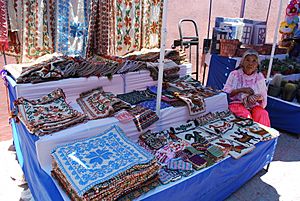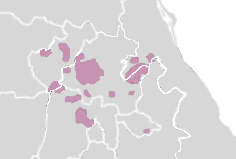Otomi facts for kids
|
Otomi dancers from San Jerónimo Acazulco, Mexico state performing the traditional danza de los arrieros
|
|
| Total population | |
|---|---|
| >300,000 | |
| Regions with significant populations | |
| Mexico: Hidalgo, Edomex, Querétaro, Puebla, Veracruz, San Luis Potosí, Guanajuato, Tlaxcala, Michoacán | |
| Languages | |
| Primary: Otomi; second: Spanish | |
| Religion | |
| Predominantly Roman Catholic and animism; minority: Protestantism and Judaism | |
| Related ethnic groups | |
| Mazahua, Pame, Chichimeca Jonaz, Matlatzinca |
The Otomi are an indigenous group living in central Mexico. They are known for their rich history and unique culture. The Otomi people are related through their language to other groups in the Otomanguean family. Their ancestors have lived in the Trans-Mexican Volcanic Belt for thousands of years.
Today, Otomi communities are found in different parts of Mexico. You can find them from northern Guanajuato to eastern Michoacán and southeastern Tlaxcala. Most Otomi people live in the states of Hidalgo, Mexico, and Querétaro. In 2015, there were over 667,000 Otomi people in Mexico. This makes them the fifth largest indigenous group in the country.
About half of the Otomi people speak the Otomi language. However, the Otomi language has many different forms, like different dialects. People speaking one form might find it hard to understand someone speaking another. The Otomi people have many names for themselves in their own languages. Some of these names are ñätho, hñähñu, ñäñho, and ñ'yühü. The name "Otomi" comes from the Nahuatl language.
Contents
Understanding the Name Otomi
The word "Otomi" is used to describe this large ethnic group and their language. This name comes from Spanish and is widely used in books about languages and cultures. Some experts have suggested changing the official name to "Hñähñú". This is the name used by the Otomi people in the Mezquital Valley. However, there isn't one common name that all Otomi groups use for themselves.
The term "Otomi" is not originally from the Otomi people. It comes from the Nahuatl language, spoken by the ancient Mexica. In Nahuatl, "otómitl" means "one who walks with arrows." Some scholars have also translated it as "bird arrowman." The Otomi language belongs to the Oto-Pamean branch of the Oto-Manguean language family. It has many different varieties, and some are not easily understood by speakers of other varieties.
Otomi Culture and Life

The Otomi people traditionally worshipped the moon as their most important god. Even today, many Otomi communities practice shamanism. They also hold ancient beliefs, like Nagualism, which involves people transforming into animals.
Like most settled Mesoamerican groups, the Otomi traditionally grew maize (corn), beans, and squash for food. The maguey plant was also very important. They used it to make fibers for weaving. They also made pulque, a fermented drink from the maguey plant. This drink was important for their economy and nutrition.
In the 1940s, a study in the Mezquital Valley showed how much the Otomi depended on maguey. Even though the land was dry, they used maguey for almost everything. They even built their huts from the plant's leaves.
The Otomi were also skilled blacksmiths. They traded valuable metal items with other groups, including the Aztec Triple Alliance. They made ornaments and weapons from metal. However, obsidian weapons were often more useful because obsidian is very sharp and light.
Where the Otomi Live
The Otomi people have historically lived in central Mexico. They are considered native to the Mexican highlands. It is believed that the Otomi have been in Mesoamerica since people first started settling down. This happened around 8,000 BCE.
The Otomi currently live in different states across Mexico. These include Mexico, Hidalgo, Querétaro, Guanajuato, Michoacán, Tlaxcala, Puebla, and Veracruz. These states are in the heart of Mexico and have a large population.
The biggest Otomi communities are in the Mezquital Valley, the Eastern Highlands, and the semi-desert area near Peña de Bernal, Querétaro. There are also groups in northern Mexico state. Smaller groups live in Zitácuaro (Michoacán), Tierra Blanca (Guanajuato), and Ixtenco (Tlaxcala). Many Otomi people have moved to big cities like Mexico City, Puebla, Toluca, and Santiago de Querétaro to find work.
A Look at Otomi History
Historians have not always focused much on the Otomi people's history in Mesoamerica. Long ago, great cities like Cuicuilco, Teotihuacan, and Tula thrived in areas where the Otomi lived. Even the Aztec Triple Alliance had areas with many Otomi people.
However, the Otomi are rarely mentioned as key players in ancient Mexican history. This might be because many different groups lived in central Mexico at that time. It was hard to tell the Otomi's contributions apart from their neighbors. Recently, more interest has grown in the Otomi's role in the cultures of the Trans-Mexican Volcanic Belt.
Otomi Peoples in Ancient Times
By 5,000 BCE, the Otomi people were a large group. Their languages spread and changed after they started farming crops like maize, beans, and chili. This is known because many words for farming are similar across Otomi languages.
The proto-Otomanguean group split into two main language branches. These became the eastern and western Otomi language families we know today. It is thought that the Oto-Pames, part of the western branch, arrived in the Basin of Mexico around 4,000 BCE. They likely came from the south, not the north.
Some historians believe the Otomi were the first people in the Valley of Mexico. However, they were later pushed out by the Tepanec in 1418. The Otomi were one of many groups living in Teotihuacan, a very important ancient city. When Teotihuacan fell, it marked the end of the Classic Period.
After this, new groups speaking Nahuatl arrived in central Mexico. They began to move the Otomi eastward. The Otomi then settled in the Eastern Highlands and parts of the Puebla-Tlaxcala valley. Later, large states led by Nahua peoples developed in Otomi territory. Around the 9th century, the Toltecs made Tula a major city. Many Otomi lived in the Mezquital Valley and other areas nearby.
Around 1100 AD, Otomi-speaking people formed their own capital city-state called Xaltocan. Xaltocan became powerful enough to demand payments from nearby communities. But in the 14th century, the Mexica and their allies conquered the Otomi kingdom. The Otomi then had to pay tribute to the Triple-Alliance. Many Otomi people moved to new lands east and south of their old territory. Some stayed near modern-day Mexico City, but most settled in the Mezquital Valley in Hidalgo, the highlands of Puebla, and other areas.
The Spanish Conquest
A large number of Otomi people lived in the state of Tlaxcala. Although some reports say that Spanish Conquistador Hernán Cortés first attacked the Otomi at Tecoaque, they later joined forces with him. They helped Cortés fight the Aztec Triple-Alliance, which led to its defeat.
This alliance allowed the Ixtenco Otomi to expand again. They founded the city of Querétaro and settled in many towns in what is now Guanajuato. However, the Otomi of Mezquital resisted the Spanish. They continued to raid Spanish settlements in Hidalgo. This state of war lasted until the first silver mines were opened.
The Ixtenco Otomi's alliance with the Spanish led many to become Roman Catholic. But they also kept their ancient customs. During colonization, the Ixtenco Otomi language spread to other states like Guanajuato and Querétaro. Most Otomi remained farmers. In the Mezquital Valley, the land was dry and not good for farming. Many Otomi people worked as laborers for each other.
Life During the Colonial Period
When the Spanish arrived in Mesoamerica, they took control of the indigenous peoples. By the 1530s, Otomi communities in the Mezquital Valley were divided into encomiendas. Later, new laws created "Indian republics." These allowed Otomi communities some self-rule from the Spanish.
These Indian republics, along with local councils (cabildos) and recognition of communal lands, helped the Otomi keep their language and culture. However, indigenous communities often lost their lands throughout the three centuries of Spanish rule.
Some Otomi families were forced to go with the Spanish to conquer northern territories. These areas were home to warlike Arido-American peoples. The Otomi helped settle cities like San Miguel el Grande and others in El Bajio. They helped nomadic groups settle down and become Christian.
By the 19th century, many Otomi still lived in El Bajio. Their descendants remain in places like Tierra Blanca and San Miguel de Allende. Otomi people also moved to places like San Luis Potosí to defend cities from attacks. Many Otomi communities were also greatly reduced by diseases brought by the Spanish.
Modern Times: 19th and 20th Centuries
During Mexico's War of Independence, the Otomi joined the rebellion. They wanted their land back that was taken under the encomienda system.
Around the 1940s, the government promised to help indigenous people with education and jobs. But these promises were not fully kept. The Otomi continued to farm and work as laborers. They were often taken advantage of in the larger economy.
After gaining independence, the Mexican government admired the ancient Aztecs and Mayans. However, they often ignored living indigenous groups like the Otomi. Only recently have researchers started to study the Otomi's ancient way of life.
The Mexican government now calls itself a pluricultural nation. This means it aims to help its many indigenous populations, including the Otomi. But there is little proof that much is truly done to help them.
Many Otomi descendants have moved to other regions. Yet, parts of their ancient culture are still present today. In some parts of Guanajuato and Hidalgo, you can hear prayer songs in Otomi. Elders share stories with young people who understand their native language. Still, not much attention is given to Otomi culture in education. Because of this, many Otomi descendants know little about their own history.
The Otomi Language
The Otomi language belongs to the Oto-Pamean languages family. This family also includes languages like Chichimeca Jonaz and Mazahua. The Oto-Pamean family is part of the larger Oto-Manguean languages group. This is one of the oldest and most diverse language families in Mesoamerica.
Otomi languages are closely related to the Mazahua language. This language is also spoken in the state of Mexico. Studies suggest that Otomi and Mazahua split into separate languages around the 8th century CE. Since then, Otomi has developed into the different forms spoken today.
What we call "Otomi language" is actually a group of related languages. The exact number of these languages varies depending on who you ask. Some sources say there are nine different varieties of Otomi. Others suggest there are four main Otomi languages.
In 1995, about 50.6% of the Otomi population spoke their native language. This was about 327,319 speakers. However, the number of Otomi speakers has gone down in recent years. This is partly because people move from their communities to cities. In cities, they mostly speak Spanish.
The push for indigenous people to speak Spanish has also played a role. For a long time, it was thought that learning Spanish meant giving up your native language. This was supposed to help indigenous people join Mexican national culture and improve their lives. However, these programs have been criticized. They often lead to the loss of native languages and haven't always improved living conditions.
Notable Otomi People
- Xiye Bastida, Environmentalist
- Martina García Cruz, artisan
- Macedonia Blas Flores, Human rights activist
- José Luis Romo Martín, Painter
- Fortunato Moreno Reinoso, Artisan
- Adela Calva Reyes, Writer
- Kevin
Images for kids
Template:KIDDLE XL START
See also
 In Spanish: Pueblo otomí para niños Template:KIDDLE XL END
In Spanish: Pueblo otomí para niños Template:KIDDLE XL END





